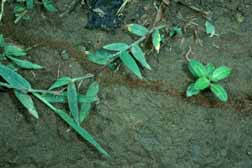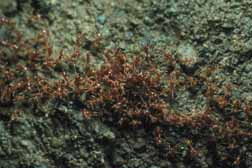Ecitoninae, Formicidae, Hymenoptera, Insecta, Arthropoda, Animalia
Range
Mainland Neotropics from Mexico to Argentina. Costa Rica: widespread.
Identification
Posterior face of propodeum straight, not concave, as long or longer than dorsal face; eye without distinct convex cornea; apex of scape does not exceed eye level; anteroventral tooth of petiole broadly triangular, shallow to nearly absent; face with abundant strong puncta; mesosomal dorsum with roughened sculpture; pilosity of mesosomal dorsum relatively dense, short, and of uniform length (contrasting with swainsonii, which has longer, sparser pilosity of variable length).
Similar species: swainsonii.
Natural History
I know this species from several widespread and diverse situations. Dana Meyer collected workers from a rotten log at Sirena in Corcovado National Park. I collected workers from a column on the main road in the Monteverde Cloud Forest Reserve, at 1500m elevation. I observed the column at 1240hrs. The column was tight, with rows of stationary workers on the sides, mandibles open and pointed upward (Fig. 1). The column was partially on open ground, partially under a soil-covered gallery before disappearing underground. There were several phorid flies running with the column.


Figure 1. Column crossing road in Monteverde.
Comments
I do not have a lot of faith in this identification. I have never seen types. It keys to this species, more or less, in Watkins (1976). But this species is near the end of the key, showing that it is a very generalized Neivamyrmex with no distinctive features.
This species was previously known as spinolae (Westwood 1842) (spinolai in Borgmeier 1955). Bolton (1995) showed that is was a junior homonym and used the oldest junior synonym as the replacement name.
Literature Cited
Bolton, B. 1995. A new general catalogue of the ants of the world. Harvard University Press, Cambridge, Mass.
Borgmeier, T. 1955. Die Wanderameisen der neotropischen Region. Studia Entomologica 3:1-720.
Watkins, J. F., II. 1976. The identification and distribution of New World army ants (Dorylinae: Formicidae). Baylor University Press, Waco, Texas.
Page author:
John T. Longino, The Evergreen State College, Olympia WA 98505 USA.longinoj@evergreen.edu